The big churn of Cults of RuneQuest books is firmly underway, as Chaosium is releasing the Mythology volume just as I write these lines… but hold off a minute and stay with me on the previous release. Let’s dive into the Earth Goddesses!
Please note that I received a review copy from Chaosium. Big thanks to Brian and Dustin! As you might expect, the Earth Goddesses is available in hardcover and PDF from Chaosium, and in PDF from DriveThruRPG (affiliate link).
Bow for the Earth Goddesses
The Earth Goddesses book looks almost as beautiful as the Lightbringers one at first glance. Here we set aside the macho bravado of the many fighting barbarian deities for grain goddesses, musical deities, and axe-wielding feminists. More or less.
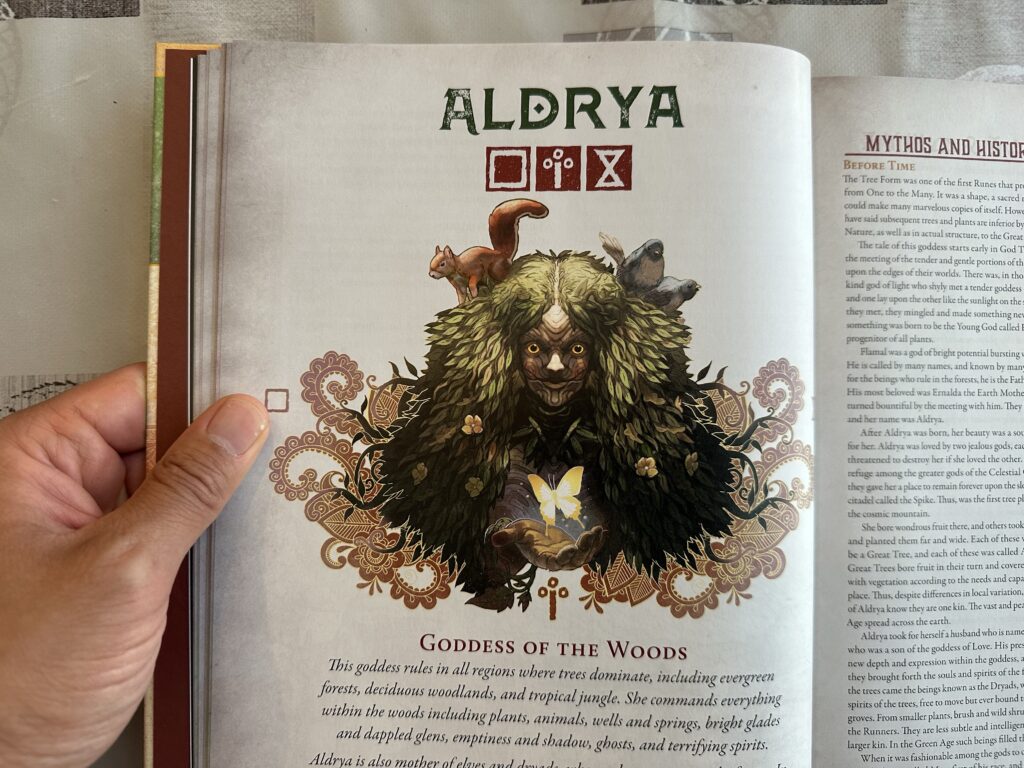
Loic Muzy’s chapter-title pieces are just as great the ones in the Lightbringers book, but I found a lot of the other illustrations to be not as good as the previous Cults of RuneQuest volume. There didn’t seem to be as many illustrations overall, actually, and a large chunk of them were actually re-used from the Glorantha Bestiary, the Guide to Glorantha, and so on. The Lightbringers volume, in comparison, had all-original art.
So past the initial flip through, I actually felt a bit let down by the Earth Goddesses book. Earth and fertility deities are just as important in Glorantha as they were in ancient times on our planet, and that’s one of the points where Glorantha differs from many other fantasy worlds, which tend to relegate this stuff far behind the “adventuring” deities… or even skip it altogether. It would have been great to see the role and importance of these Earth goddesses reflected in the art, especially with “slice of life” pieces to help picture how cool an Ernalda or Eirithia initiate can be in context.

Another disappointment was with the editing of the book. I had noted previously that the Lightbringers book felt like a step up from the previous RuneQuest books, but we have stepped back down with the Earth Goddesses as far as I’m concerned. There are typos, of course, but also weirdly structured sentences. There is repeated material between nearby pages which feels more like revision errors than repetition for convenience (e.g. the story of Aram Ya-Udram, or the Goddess Switch experiment). There are “RQ2-isms” such as references to “spending POW” or to long gone spells like Mindlink, all of which date back to RuneQuest 2nd edition. Yet another example is the write-up for Eirithia, the Herd Mother, which references the “Five Nations of Prax”. This is of course directly lifted from the RQ2-era “Cults of Prax” supplement, which had an introduction explaining who these five nations are. But there is no such introduction here. Sure, the RuneQuest rulebook describes the “five Great Tribes of Prax”, and it doesn’t take a genius to make the correspondence, but it gets confusing when, in the same section, the Earth Goddess book makes the distinction between “nations” and “tribes”!
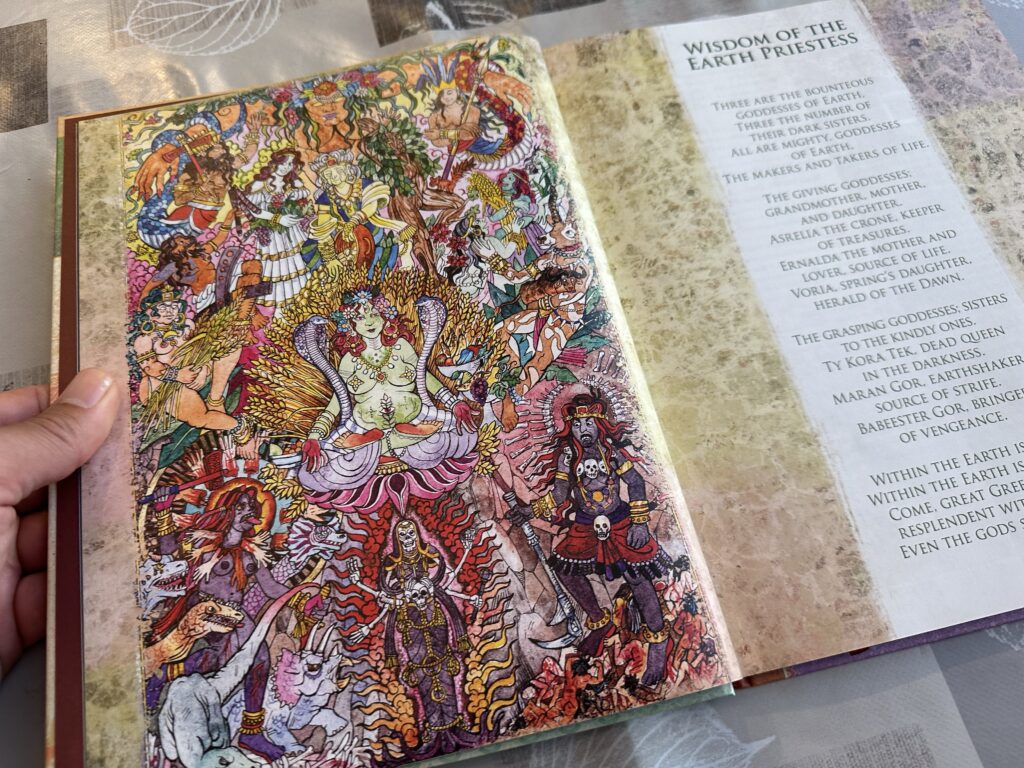
Anyway, this isn’t a big deal, but I found the Earth Goddess book sprinkled with many small errors like this, and it piles up after a while.
A Familiar Structure
The Earth Goddesses book follows the same structure as the Lightbringers book. This will be most probably valid for all subsequent books of the series (except for the Mythology book which isn’t a splatbook of playable cults), so many of the points I made in my previous review are still valid here.
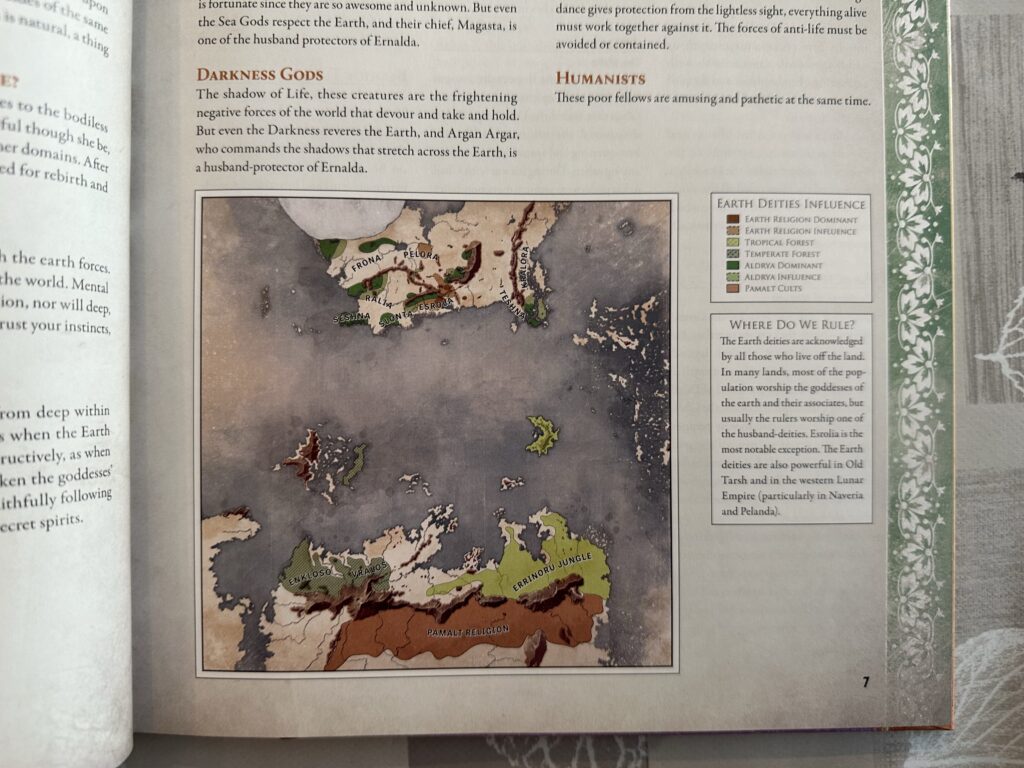
These general points are, in their short version:
- There is a lot of world-building sprinkled all across the book, especially in the “Since Time Began”, “Nature of the Cult”, and “Organization” sections of each cult write-up. It’s often a great read when a cult goes beyond basic information that the gamemaster could have made up, and instead provides flavourful material with details that only an ancient world historian could have dreamed up.
- The book continues to hint at a broader Glorantha, one that goes beyond Dragon Pass. Once again, whether the mention of far-away unfamiliar places makes you buy the Guide to Glorantha or make up your own world is up to you. Personally I’m hoping to see people do both.
- Cults in the Cults of RuneQuest series define both gameplay and roleplaying opportunities, since they outline the magic, skills, and Passions, your character will get, but also their position in the world and general outlook on life. So once again, make sure to discuss this with your players during Session Zero.
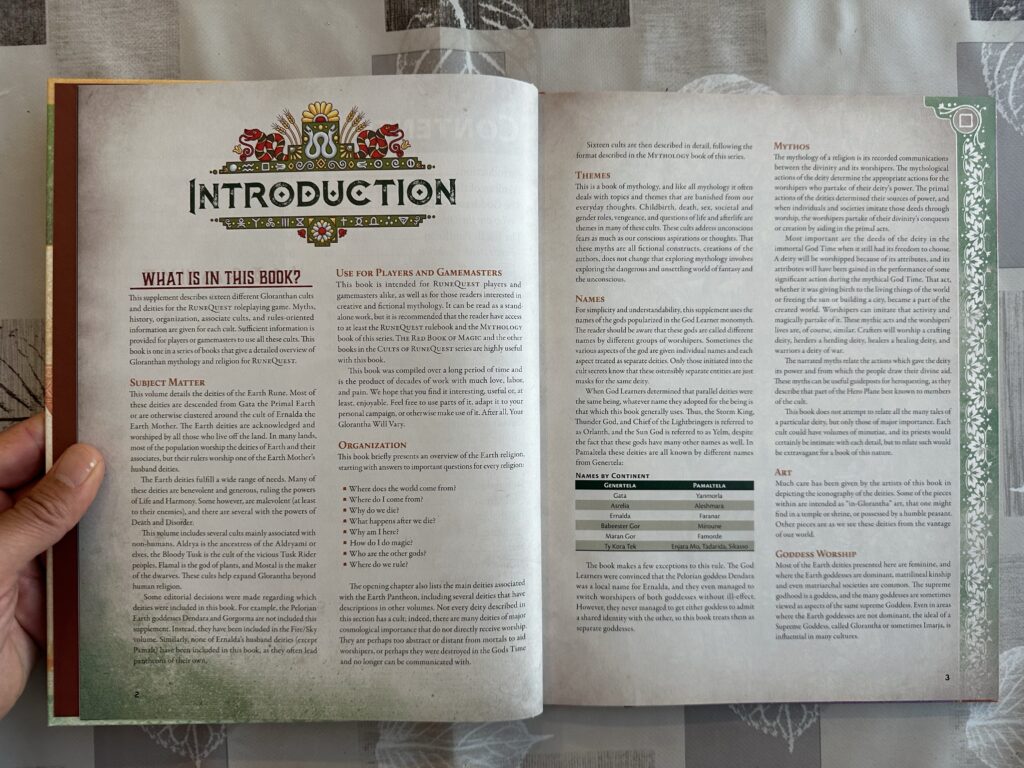
There are a couple of small differences too.
The introduction gains an interesting table of name correspondences between Genertela and Pamaltela. Generally speaking, this book leans more into how the same goddess might be known under different names and aspects in different cultures. I personally like this sort of detail (up to a point!) because it adds cultural flavour to the world and makes it feel “lived in”.
The description of other pantheons made me chuckle a bit: the Sky Gods are “good fathers, bad husbands”, and the Storm Gods are “good partners but bad masters”. True, dat.
Oh Holy Day
One thing I forgot to mention in the Lightbringers review is that there was a missed opportunity to add a short description of a cult’s main holy days. A name, or sentence about what is typically done in terms of worshipping and festivals and so on.
This would have greatly helped run games that actually feature these holy days properly, and not as a simple dice roll to replenish Rune Points. Only very very few cults (like Ty Kora Tek‘s High Holy Day) get this treatment. As far as I’m concerned, this is one reason hunting down old out-of-print HeroWars books is still worth doing: these books do contain information for all holy days of all cults.
What on Earth?
The Earth Goddesses book’s main attraction is of course the write-up of 15 cults loosely related to the Earth. This is 4 cults less than the Lightbringers book, and one cult less than what the blurb on the back cover claims (well, unless they count Caladra & Aurelion as two deities?) The book is about 140 pages long, a bit shorter than the 164 pages of the Lightbringers book.
While the selection of deities in the Lightbringers book was clearly tracing everything back to Orlanth‘s family and friends, the selection in the Earth Goddesses is a bit more diverse. Besides Ernalda and her family you also get other gods loosely related to the “Earth” theme like Mostal, the dwarf god, Pamalt, the land god of the southern continent, or the Cult of the Bloody Tusk, which is for the evil and nasty and super cool Tusk Riders. I found that it makes this book slightly less cohesive than the Lightbringers.
Snakes and Udders
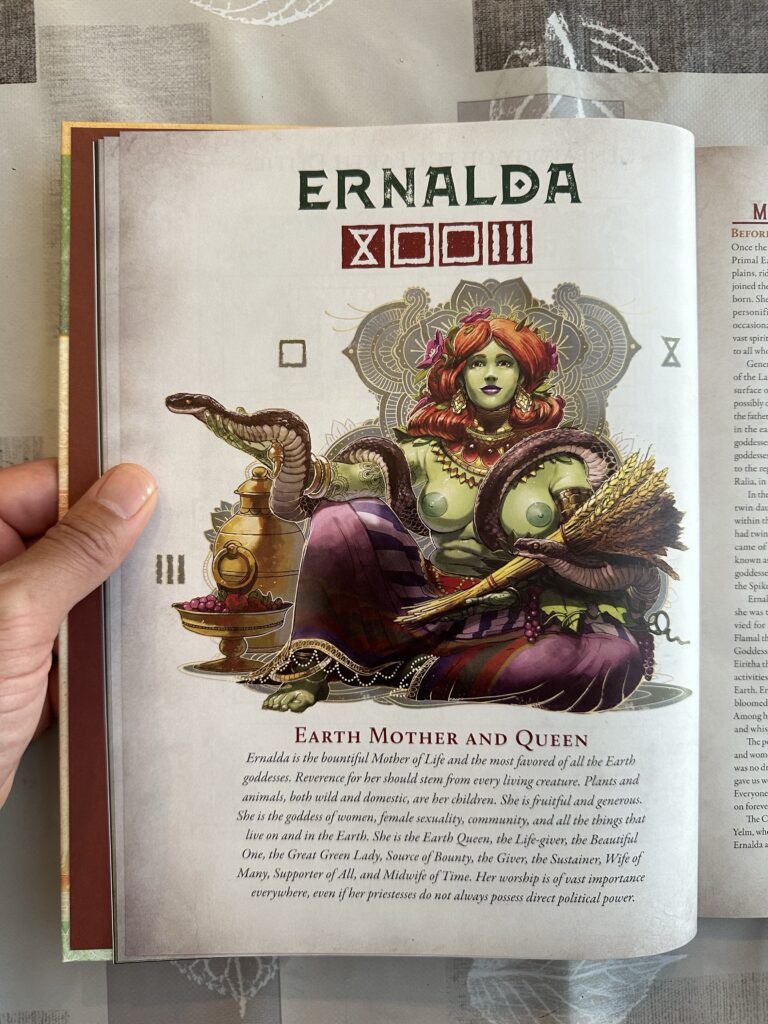
Sadly, the cult write-ups section starts with a disappointment. Ernalda, the Earth Mother, Queen of the Gods, gets “only” 14 pages. Sure, this is a lot more material than what old-hands might have been used to with previous editions, but compare that to Orlanth‘s 24 pages in the Lightbringers book and suddenly they don’t seem so much on an equal footing anymore. Orlanth gets three times as much mythos, history, and cult information as his wife. Aldrya, Caladra & Aurelion, Mostal, or Pamalt get more material overall than Ernalda. And although Ernalda‘s whole shtick is supposed to be her large network of husband protectors, associated cults, subservient cults, and so on, she still gets a couple pages less than Orlanth on that topic.
Page counts aside, neither Ernalda‘s mythos nor her cult’s history really give us a sense of the cunning, clever, proactive woman she is supposed to be. There are a couple of short references to, say, her cult playing both sides during the Broken Council era, but we don’t really get stories in the vein of “look at this awesome thing Ernalda did!” in the same way that we get Orlanth‘s many heroic feats. Ernalda‘s mythos reads more like a collection of what children she had with what husband, and what they did. We’re mostly told of what Ernalda was given, and what she gave in return, as opposed to anything she actually did. Phrasing it like “Ernalda took Orlanth as a husband” (instead of the other way around) doesn’t make her any less passive: at the end of the day, her story is about being in an abusive relationship and having to find a new boyfriend to get her out of it. The only vague mention that she might have orchestrated her own freedom is a measly “With her aid…” prefacing how Orlanth killed Yelm.
This isn’t, in my opinion, what the Queen of the Gods deserved.
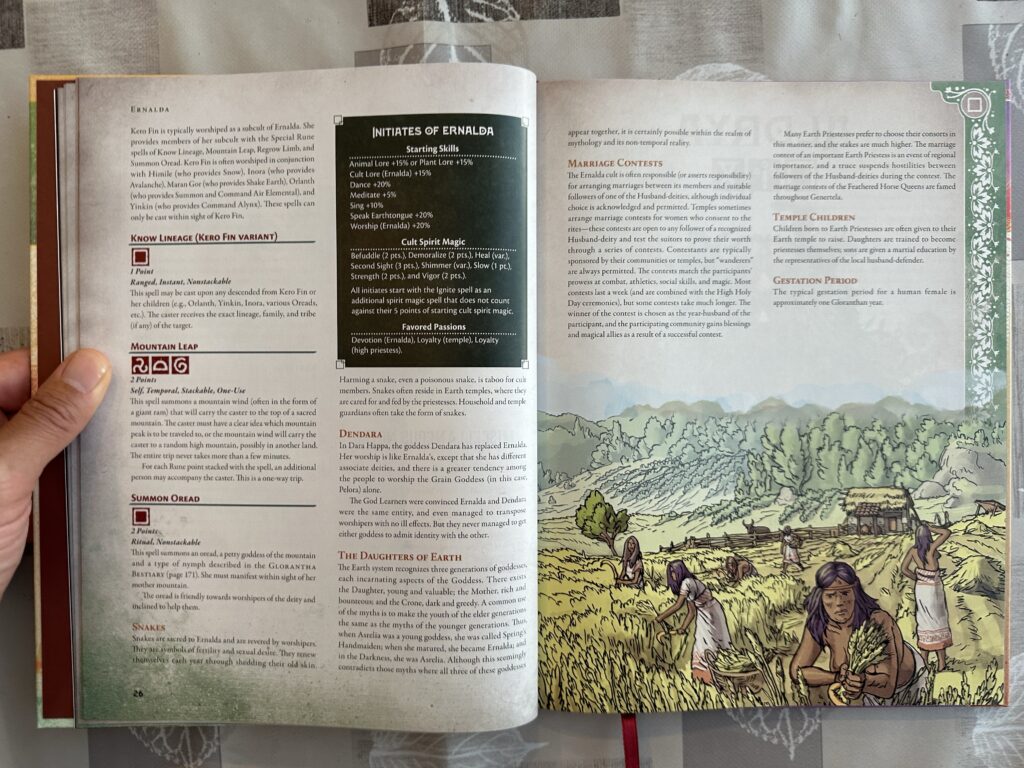
I really wish Chaosium would more heavily modernize this cult, but if they’re not doing it for the RuneQuest mechanics, they’re not going to do it with the lore either I guess. Actually, I’m sure they don’t see any problem with either, and it’s quite possible that the majority of RuneQuest players agree with them anyway… you tell me! Maybe I’m in the minority! But this is, you know, my website and my opinion, so there.
On the good side, the “Social/Political Position and Power” does at least make it clear that Earth priestesses have a lot of influence in Orlanthi politics. And the iconography, along with Loic Muzy’s wonderful chapter plate, don’t shy away from some depiction of Ernalda‘s fertility aspect.
Changelings and Evil Twins
The rest of the Earth Goddesses is, like the Lightbringers book, a collection of cults of varying interest to a given reader.
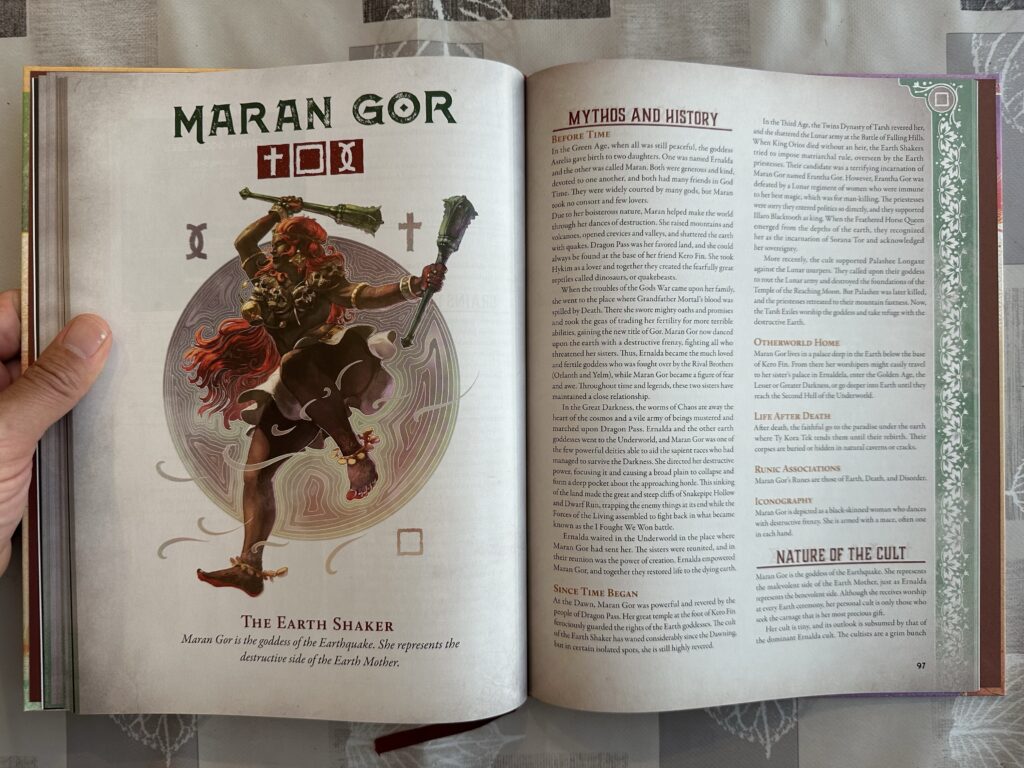
I personally really liked the Aldrya cult write-up. The “Elf Story” was pretty evocative (it’s virtually the same as what Greg Stafford wrote in 1998, only with elf-specific names replaced by God Learners names), and the absolutely brutal initiation ritual for non-elves gave me very good “folk horror” vibes1Frankly, I think the elves are running a scam and replacing humans with changelings, but hey, feel free to believe you’re still “yourself” after this!. By comparison, the Cult of the Bloody Tusk write-up looked rather tame… y’all know I love the Tusk Riders, so I was sad to not find more horrible stuff in that one.
Strangely enough, the Caladra & Aurelion cults gets a lot of material. Of course I later realized that this is because it’s lifted from Different Worlds #15, where Charles Huber (whose name is weirdly missing from the Earth Goddesses’ credits) vastly expanded on the short blurb that Greg wrote in Wyrms Footnotes #10.
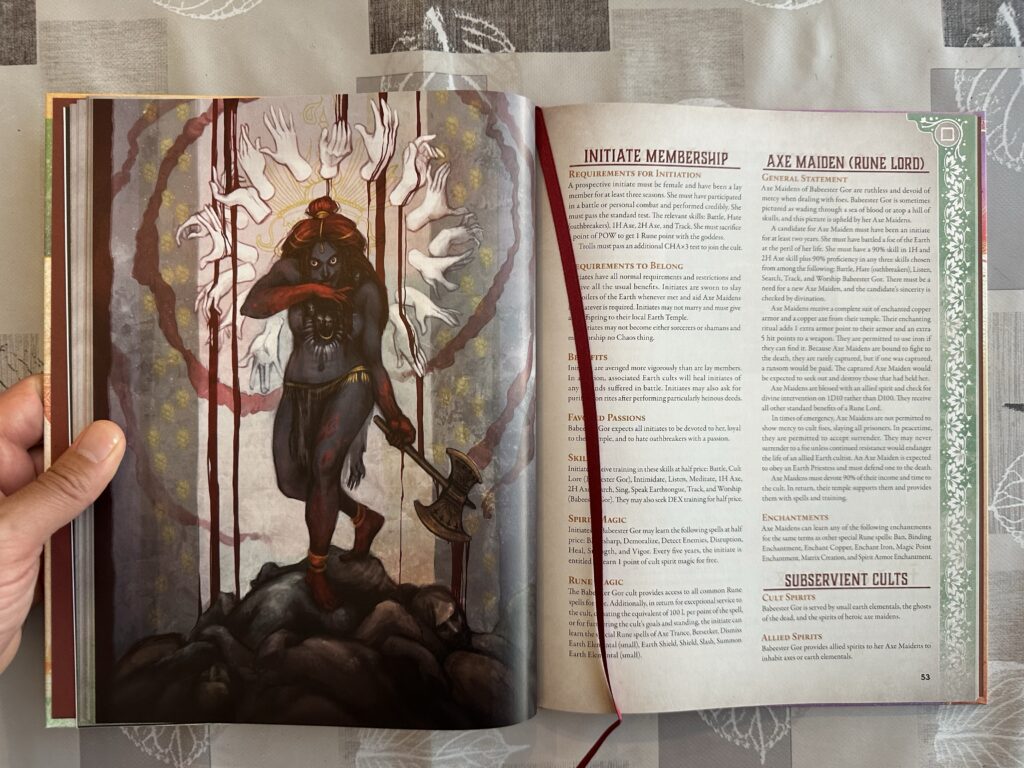
The rest is interesting, I guess, but I was a bit less excited overall compared to the Lightbringers book. With the Lightbringers, I could see myself using all the cults in my game, for NPCs or world-building or whatever, except maybe Ygg (we need to get to the ocean first!) By comparison, the Earth Goddesses book has a handful of cults that I might not even bother including in my game unless my players are somehow interested to see them in action.
For instance, the cult of Mostal has some in depth look at dwarf culture, but not much new if you already have the Glorantha Sourcebook or Guide to Glorantha (which is a good thing, newcomers don’t need yet another book) The new dwarf sorcery spells leave me rather cold, and overall I find the Mostali to not be as weird and alien as they could be. I’ll probably keep doing my own take on them. Another example is Pamalt‘s chapter, which is a very interesting entirely new look at Pamaltelan culture but, well, I personally have no use for this in my game. And to be clear, these aren’t criticisms of the book per se. If anything, they are a criticism of the general creative approach to Gloranthan gaming material which stipulates that, well, Pamalt is in Glorantha, so Pamalt must be in RuneQuest. I have a few issues about this, let’s say, “reverse Sim-Glorantha” approach, but this review is already getting long so we’ll talk about this later.
Still, we do get a good amount of material on some of my favourite cults: Babeester Gor and Maran Gor. A couple other cults are newly found interests of mine, too. For instance, I’m looking forward to include Asrelia and Ty Kora Tek initiates into my players’ Bachad tribe.
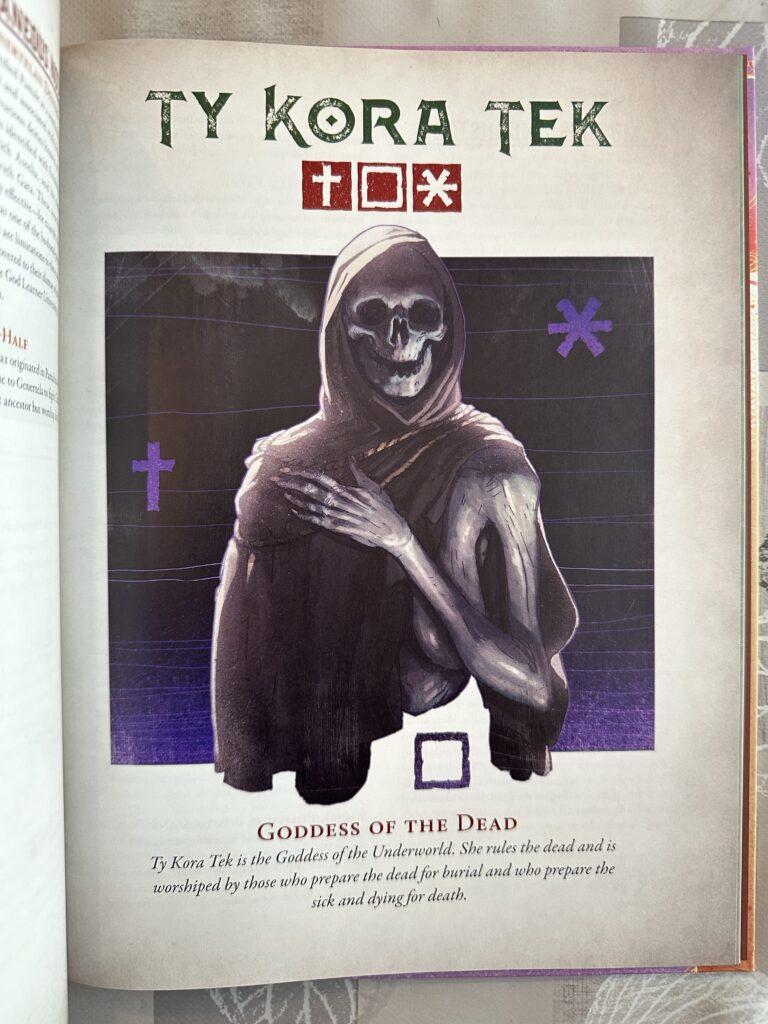
One surprise was the cult of Donandar. If you like playing the Bard class in D&D, this might be the cult you’re interested in. But where the Bard gets abilities such as giving inspiration to your teammates and throwing your enemies off guard with biting repartee, the Donandar cult gets something entirely different! You can take control of your enemies and “puppeteer” them into attacking their friends! You can force a crowd or opposing force into a St Vitus-type dancing mania! You can play a flute and steal all of the children from an ungrateful village! And more importantly, for the added cost of an illusion of yourself, you can teleport anywhere in sight!2This is a lot simpler than what Angier and Borden have to do for the same trick, just sayin’ I can’t wait to spring some Donandar thief on my game’s city of Alone.

The Earth Goddesses continues the work started with the Lightbringers book in providing the “missing piece” of the Glorantha puzzle: a view of the cultures of Glorantha through their religious beliefs and practices. However, I found the Earth Goddesses inferior and disappointing in places compared to its predecessor.
But despite its shortcomings, this is obviously the book to have if you want to include any Earth cult in your games… and I’m going to assume this encompasses all games set in Glorantha. Several passages in the Earth Goddesses unlocked new visions of Glorantha for me, and new opportunities for my game, and that’s worth something.


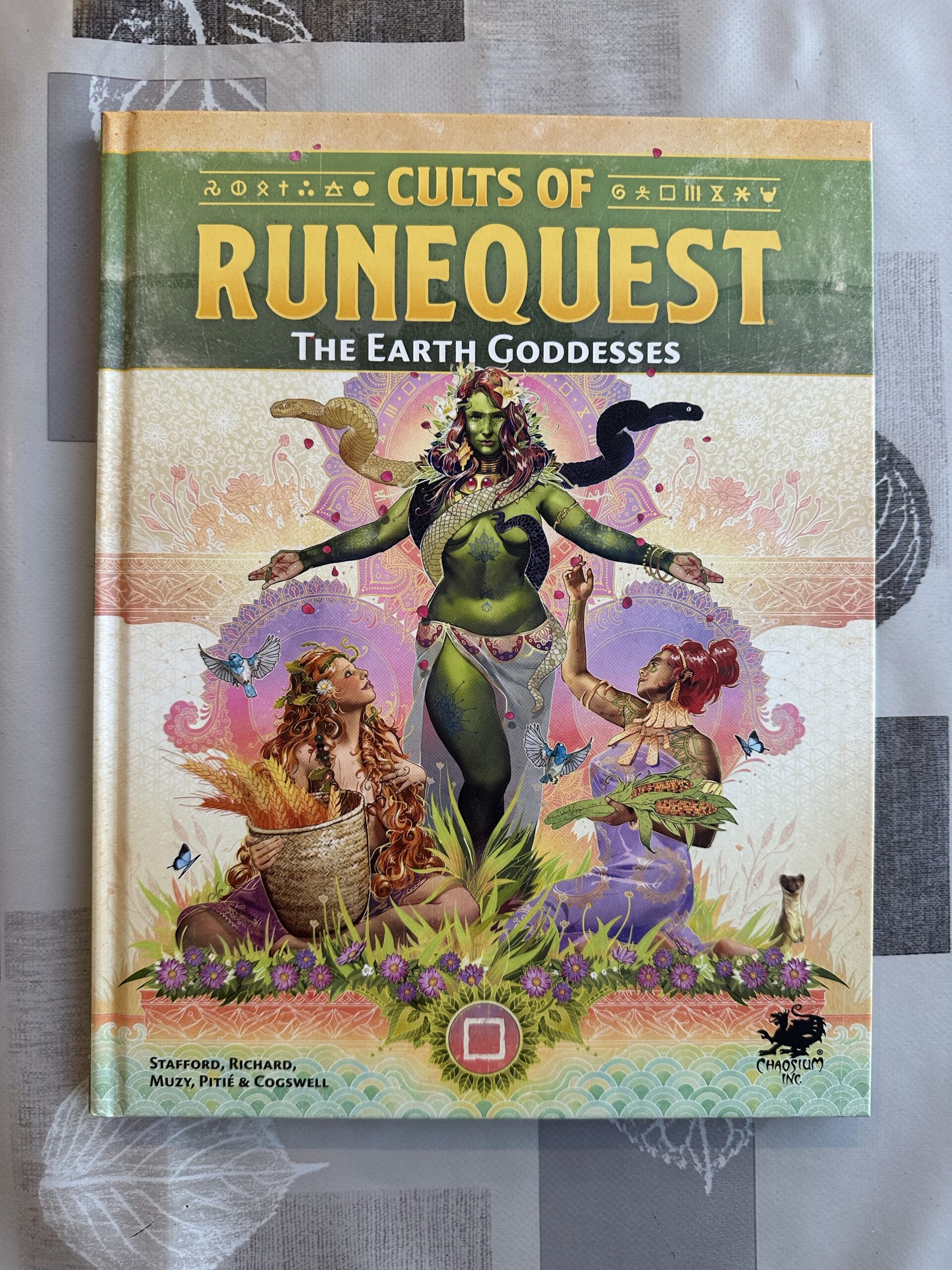
I wholeheartedly agree that Glorantha would benefit from a new approach. At first I was completely enchanted by the world but now I haven’t read anything really new for a year. I read the same things over and over again.
Another problem is that the books are not written from a role-playing perspective. The first thing a PC experiences in a cult are sacred rituals that, as you wrote, are missing from almost every description. For example I still know almost nothing about human sacrifices in the cult of Maran Gor. I can get a lot of information about the Yelm cult in Dara Happa but I don’t know anything about the Yelm cult in Grazelands (I have two characters in my group from there) and I have less and less hope that the new Cults book will help.
Glorantha is a fantastic world and Runequest is fundamentally a good system but it feels like I’ve travelled back to the 90s.
I don’t think it needs a new approach overall (it’s a great setting as is) but a few specific things, like Ernalda’s myths, would greatly benefit from heavy revisions.
Hopefully the Solar cults book will shine a light (haha) on the various versions of the Yelm cult. We’ll see… thanks for reading and commenting!